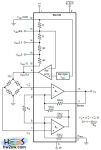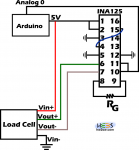At this point we need a precise voltage amplifier. A digital component that fit at our needs is INA125.
You can get the data-sheet from here : ina125
From the data-sheet we can get a generic schematic

Notice that INA125 have a gain range from 4 up to 10.000
This gain is regulated by the resistor RG located at the pins 8-9
The gain formula for this device is :
Gain=4+(60000/RG)=>RG=60000/(Gain-4)
In our case for a 5V arduino reference we need
RG=60000/(896-4)=>Rg=68 Ohm
In the 1,1V reference case we have
RG=60000/(196-4)=>Rg=312 Ohm
The connection with the arduino will be like below

The same procedure will be followed with a 20Kg load cell.
The load cell manufacturer once again says that the rated output is 1,0946 mVout/Vin
This means that 1,0946 mVout/Vin
So if we drive the loadcell with arduino (5V) we have
Vin = 5V and mVout-max=1,0946*5=5,473mV(full loaded with 20Kg)
So at 20000gr we have a mVout-max=5,473mV
At 1gr we have x mV
So x=0,00027365 mV/gr
By default arduino uses an analog reference of 5V this means that you have a resolution of 4.9 mV/step as we said before.
We need a precise amplifier that can increase the electrical signal in order to get 0,00027365 mV/gr
So we need a gain like this :
Gain = (arduino mV/Step) / (loadcell mV/gr)
Gain (5v) = 4,9 mV/step / 0,00027365 = 17906
The maximum gain of INA125 is 10000, so a gain that high, using 5v as analog reference, is not possible.
Let's see what happens at 1,1V using analogReference(INTERNAL);
We know that 1.1v/1024 steps = 0,00107421875 v/step = 1,07421875 mV/step
So :
Gain (1.1v) = 1,07421875 mV/step / 0,00027365 = 3925
This time the gain is reachable! We need a resistor :
RG=60000/(Gain-4)=>Rg=15,3 Ohm
All the schematics can be downloaded from here : loadcell-schematics
Now we are ready to start constructing Liquid Filler !!!
See you in the next article!
Pingback: Arduino – Pressure Component Investigation | Interactive Design Blog - Reece Collingbourne
Pingback: Measure Weights With Arduino | Click & Find Answer !